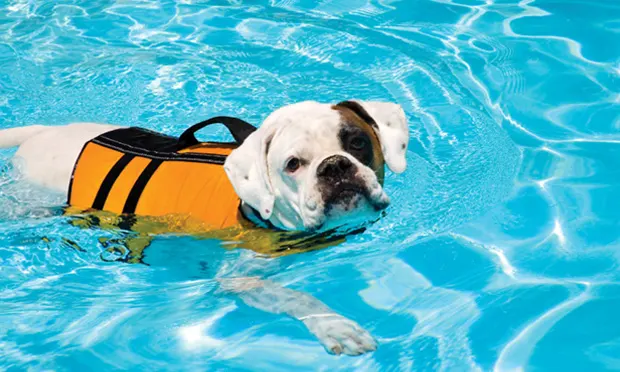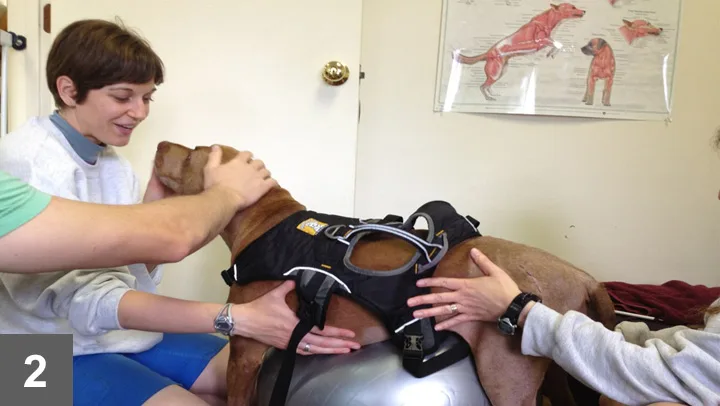Top 5 Conditions That Respond to Rehabilitation Therapy
Suzanne Starr, DVM, CCRP, Paws in Motion Veterinary Rehabilitation Center, Natick, Massachusetts

The goal of physical rehabilitation, in combination with medical and surgical care, is to restore normal or near-normal mobility and musculoskeletal function. Manual therapy includes massage, stretching, passive range-of-motion (ROM) exercise, and joint mobilization. Modalities include heat and cold therapy, therapeutic neuromuscular electrical stimulation, laser therapy, and therapeutic ultrasonography. Targeted exercise can include use of exercise balls or wobble boards, cavaletti rails (ie, horizontal poles positioned at varying heights and distances for dogs to step over), underwater or land treadmills, and pools.
Although dogs with assorted conditions can benefit from physical rehabilitation, the following are the top 5 canine conditions that the author believes best respond to rehabilitation therapy.
1. Postoperative cranial cruciate ligament rupture surgery
Cranial cruciate ligament disease is one of the most common orthopedic conditions in dogs. Surgery is arguably the best approach to restore stability when the cruciate ligament has been damaged. Regardless of the surgical procedure, rehabilitation initially involves pain management, massage, passive ROM, and icing. As tissues heal, patients often progress to weight-shifting exercises and water treadmill walking (Figure 1). As lameness improves, therapy may include leash walking (ideally involving hills), followed by jogging and trotting.

Because underwater treadmill walking has little impact on the joints, it can benefit dogs affected by orthopedic and neurologic conditions.
2. Postoperative femoral head and neck ostectomy
Femoral head and neck ostectomy is most often performed to treat Legg-Calvé-Perthes disease (ie, avascular femoral head necrosis), coxofemoral luxation, and femoral head and neck fracture. In addition, this surgery can be a salvage procedure for painful hip dysplasia or osteoarthritis. Adequate pain management is important to encourage early use of an affected limb. Early therapy involves massage and gentle, passive ROM. After the skin incision has healed, underwater treadmill activity can promote partial weight bearing and return to normal gait. Once the affected limb is used in a four-legged walk, additional weight-bearing exercises can be introduced. Tools (eg, balance board, exercise ball) can help improve weight bearing while strengthening the core.
3. Spinal cord diseases
Common spinal cord diseases include intervertebral disk disease, fibrocartilaginous embolism, degenerative myelopathy, spinal trauma, and inflammatory CNS disease. Classic signs are proprioceptive deficits and severe paresis or paralysis of the pelvic or all limbs, depending on lesion location. A thorough neurologic examination is essential. When indicated, cerebrospinal fluid tap and MRI or CT should be pursued. Once the diagnosis has been confirmed, therapy, including physical rehabilitation, can be planned. Physical rehabilitation therapy has a role in both these circumstances.
Therapeutic goals for dogs with spinal cord disease include reducing pain, maintaining joint flexibility, preventing or reducing muscle atrophy, and restoring coordination and proprioception. Techniques depend on the severity of signs and spinal cord disease, but massage, passive ROM, targeted exercises using an exercise ball (Figure 2), and water therapy are commonly used. In dogs with severe paresis or paralysis, the benefits of water therapy are extensive. Buoyancy of the patient when surrounded by water strengthens mobility, as dogs often initiate movement in the water before initiating movement on land. When the dog can walk without support, adding exercises such as stepping over obstacles (eg, cavaletti rails) can help improve overall coordination.

Targeted exercises, such as using an exercise ball, can help core conditioning, weight bearing, balance, and ROM.
4. Osteoarthritis
Patients with osteoarthritis can benefit from a multimodal therapeutic approach. A patient’s condition often deteriorates rapidly becomes a vicious cycle: because the arthritis is painful, the animal typically becomes more sedentary, leading to muscle atrophy and weight gain, subsequently worsening the condition. Pain management through analgesic medication and physical therapy can help. Gentle exercise in an underwater treadmill or a pool helps build muscle strength and endurance while minimizing stress on painful joints. When the patient is able, targeted weight-bearing exercise is ideal to strengthen the joints.
5. Obesity
In the United States, an estimated 50% of dogs between 5 and 10 years of age are overweight or obese, making this one of the most common canine medical disorders. Health problems caused or complicated by obesity include joint and/or musculoskeletal problems, exercise and heat intolerance, and pulmonary and cardiovascular disease. Although attention may be given to designing the appropriate diet for weight loss, exercise is often overlooked. When combined with caloric restriction, exercise can induce a negative energy balance critical for weight loss. Scheduled sessions of physical activity can help burn calories, build muscle mass, and improve client motivation and compliance. Exercise sessions should be customized for each patient.
Closing Thoughts
Therapists not only provide a service during rehabilitation sessions, but also participate in designing daily home plans. Clients often benefit greatly from receiving specific guidance following their pet’s injury or surgery. In addition, therapists can recommend slings, harnesses, wheels, and other assistive devices that can help patients and caregivers. It is therefore important for general practitioners and specialists to consider and discuss rehabilitation as part of their patients’ complete care plans when appropriate.